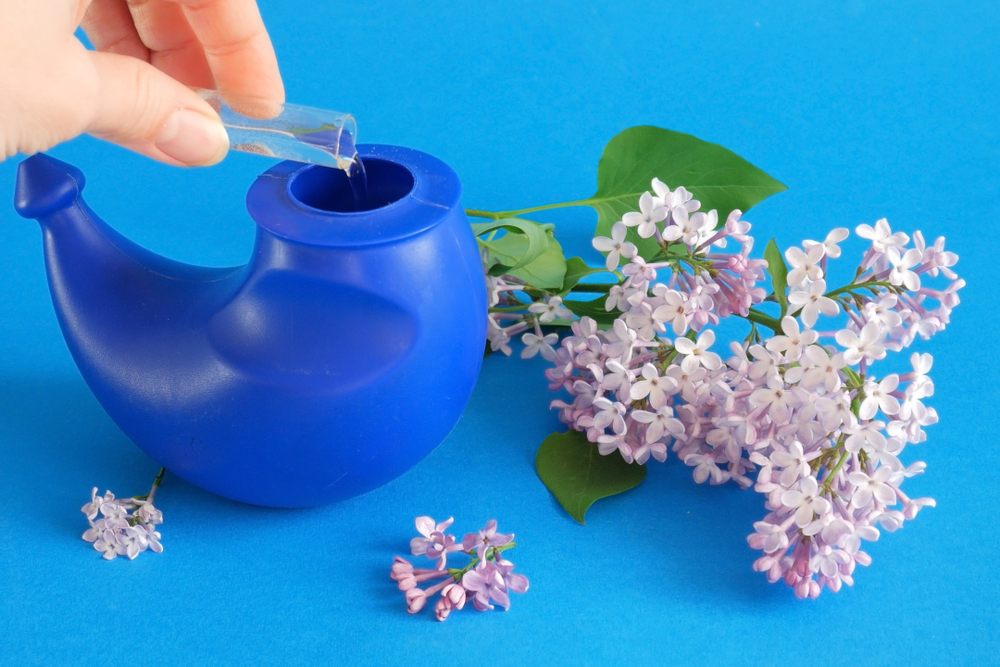That teapot-looking thing sitting in your bathroom cabinet might seem like a harmless solution for your stuffy nose, but using it incorrectly could lead to serious health consequences. Neti pots have gained massive popularity as a natural remedy for sinus congestion, but there’s more to these simple devices than most people realize.
What exactly is this weird little teapot anyway
Neti pots might look like something you’d use for a doll’s tea party, but they serve a much different purpose. Originally from ancient Ayurvedic medical traditions, these small vessels are designed to flush your nasal passages with a saline solution, washing away mucus, allergens, and irritants that cause congestion and discomfort.
The basic concept is straightforward. You fill the pot with a saline solution, tilt your head over a sink, insert the spout into one nostril, and allow the solution to flow through your nasal cavity and out the other nostril. It’s essentially a power wash for your sinuses, flushing out whatever’s causing you trouble.
When used correctly, neti pots can be remarkably effective for alleviating sinus pressure, reducing congestion from allergies or colds, and helping you breathe more easily. Many users report significant relief from chronic sinus issues that over-the-counter medications failed to address.
When this ancient remedy actually works
Neti pots shine in several common situations. During allergy season, they can flush out pollen and other allergens that accumulate in your nasal passages, potentially reducing your need for antihistamines. After exposure to irritants like dust or smoke, a quick rinse can remove these particles before they cause prolonged irritation.
For chronic sinusitis sufferers, regular irrigation can help manage symptoms and reduce the frequency of sinus infections by removing built-up mucus where bacteria like to grow. Even for garden-variety colds, a gentle nasal rinse can provide temporary relief from stuffiness and help you breathe more easily while your body fights the virus.
Multiple scientific studies support these benefits. Research published in medical journals has shown that nasal irrigation can reduce sinus symptoms and improve quality of life for people with chronic sinus issues. Some ear, nose, and throat specialists recommend nasal irrigation as part of a comprehensive treatment plan for certain patients.
The risks lurking in your bathroom sink
Despite their benefits, neti pots come with serious risks when used improperly. The most dangerous mistake is using tap water directly from your faucet. While tap water is generally safe to drink due to stomach acid and digestive processes that kill potential pathogens, your nasal passages offer no such protection.
Tap water can contain small amounts of bacteria and amoebas that, while harmless when swallowed, can cause devastating infections if introduced directly into the nasal cavity. Several documented cases of deadly brain infections have been linked to using unfiltered tap water in neti pots, with some resulting in fatalities.
The most notorious of these infections is caused by Naegleria fowleri, sometimes called the “brain-eating amoeba.” Though extremely rare, these infections have almost 100% fatality rate, making proper water safety with neti pots absolutely critical.
The water matters more than the pot
The safest options for neti pot use include distilled water, which has been purified to remove all microorganisms, or previously boiled tap water that has been allowed to cool to a comfortable temperature. Some experts also consider water filtered through systems with a pore size of one micron or smaller to be acceptable.
Store-bought saline packets designed specifically for nasal irrigation provide the proper salt concentration to match your body’s natural fluids. Using plain water without salt can actually irritate your nasal passages further, as the lack of salinity creates an uncomfortable burning sensation.
If you’re traveling, especially internationally, extra caution is warranted. Water quality varies widely, and unfamiliar water systems might contain microorganisms your body isn’t accustomed to. When in doubt, bottled distilled water is your safest bet for nasal irrigation away from home.
When to put the pot down immediately
Certain situations call for avoiding nasal irrigation entirely. If you have a nasal obstruction, deviated septum, or recent nose injury, forcing water through your nasal passages could cause pain or further damage. Complete nasal blockages prevent proper drainage, potentially causing the irrigation solution to back up into areas it shouldn’t go.
Nosebleeds are another red flag. Using a neti pot during or shortly after a nosebleed can interfere with clot formation and potentially restart bleeding. Wait at least 24 hours after a nosebleed before considering nasal irrigation.
Ear infections present another contraindication. The nasal passages connect to the middle ear through the eustachian tubes, and irrigation fluid can sometimes reach these areas, potentially worsening an existing ear infection or even causing one if the irrigation solution isn’t sterile.
The surprising pressure problem
Even the pressure you apply while using your neti pot matters. Squeezing plastic irrigation bottles too forcefully or positioning the neti pot at too steep an angle can drive solution into the eustachian tubes or sinuses with excessive pressure, causing ear pain or making sinus conditions worse.
The ideal flow is gentle and gravity-based. Your head should be tilted at approximately a 45-degree angle, allowing the solution to flow naturally through one nostril and out the other. Breathing through your mouth during irrigation helps prevent the solution from going down your throat.
Some users make the mistake of using their neti pot too frequently. While it can be tempting to irrigate multiple times daily when congestion is severe, overuse can actually wash away the protective mucus in your nasal passages, potentially increasing your vulnerability to infection.
Keeping it clean might be harder than you think
Another overlooked risk involves the pot itself. The warm, moist environment inside a used neti pot creates ideal conditions for mold and bacteria growth. After each use, thoroughly clean your pot with distilled or boiled water and allow it to air dry completely before storing.
Some experts recommend replacing your neti pot every few months, especially if it’s made of plastic that can develop microscopic scratches where bacteria can hide. Ceramic and glass pots are easier to sterilize but should still be replaced periodically.
Sharing neti pots between users, even family members, is never recommended. Like toothbrushes, these are personal hygiene items that can potentially transfer infections from one person to another, regardless of how well they’re cleaned between uses.
Making the most of nasal irrigation safely
Despite these precautions, neti pots remain a valuable tool for many sinus sufferers when used correctly. To maximize benefits while minimizing risks, warm your solution to body temperature for comfort, use the proper salt concentration, and maintain a consistent but not excessive irrigation schedule based on your symptoms.
If you experience burning, stinging, or pain during irrigation, stop immediately. These sensations usually indicate a problem with your technique or solution. The process should be comfortable, with only a mild sensation of water flowing through your nasal passages.
After irrigation, gently blow your nose to remove remaining solution and mucus, but avoid forceful blowing which can drive fluid into the sinuses or ear canals. Some drainage might continue for a few minutes after irrigation, which is perfectly normal.
For chronic sinus sufferers, consulting with a healthcare provider before starting nasal irrigation can provide personalized guidance based on your specific condition. They can identify any anatomical issues that might make nasal irrigation difficult or risky for you personally.
With proper precautions, neti pots can be a safe, effective addition to your respiratory health toolkit, providing drug-free relief from various nasal conditions. Just remember that this ancient remedy requires modern safety practices to truly benefit your health.















